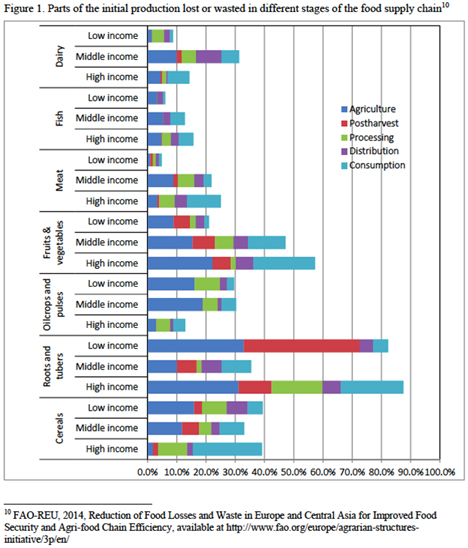Agriculture officials condemn unnecessary loss and waste of good food

Ministerial session at FAO Regional Conference for Europe calls for private and public sector action – and consumer behaviour change
As populations expand and food requirements continue to rise, the world cannot afford to continue squandering one third of total agricultural production. Coordinated and forceful actions are called for, and in many cases, the private sector will need to take the lead.
These were among the conclusions of a round-table session of agriculture ministers from across Europe and Central Asia which took place here today as part of FAO’s biennial Regional Conference for Europe.
In a paper prepared for the session, FAO examined food losses and waste in the region, comparing low-, middle- and high-income countries, and looking at seven different supply chains: dairy, fish, meat, fruits and vegetables, oil crops and pulses, roots and tubers, and cereals.
Notable differences in the patterns of food losses and waste were found depending on income levels. Most of the losses in the developed countries occur at the consumption stage, while in the middle and low-income countries the largest losses occur at the production and post-harvest stages of the value chain (see chart below).
Bread is taken as an example. Over-supply, purchasing capacity and consumer preference for fresh bread – as well as higher discard rates of other cereal products – result in nearly 25 percent wastage of cereal products in high-income countries. In middle-income countries, levels of waste fall to 8.5 percent, and in low-income countries as low as 5 percent. Another source of food waste is aesthetic standards, and consumer preference for products with a longer remaining shelf life.
Consumer behaviour is only part of the picture, however. Significant levels of food loss can occur at farm level, during storage, transport and processing.
Looking at the roots and tubers commodity group (potatoes, root vegetables), FAO’s study found that for high-income countries of the European Union and European Free Trade Association, losses at the production phase is highest, with just over 30 percent of crops lost or wasted during the harvesting process. A further 17 percent loss occurs in processing and packaging. In middle- and low-income countries, however, the study found almost no processing and packaging loss or waste for roots and tubers.
“Fruit, vegetable and milk producers [in Europe and Central Asia] are overwhelmingly small producers,” according to FAO, “and the absence of modern milking equipment and milk cooling capacity is likely to be the largest single cause of losses in the dairy sector.”
Many countries across Europe and Central Asia have already launched campaigns and programmes designed to reduce food losses or food waste, and country delegates outlined many of these during the meeting. Initiatives ranged from the establishment of food banks to the use of bioenergy and recycling, from investment in farm-level technology to improved logistics and infrastructure.
The ministers and other delegates called on FAO to intensify its analytical work to better understand the causes of food losses and waste, and help countries build their own capacity for improved statistics and data. The Organization will also facilitate exchange of solutions and best practices for addressing the problems, presenting policy options that governments can pursue. Examples include support for the development of producer organizations so that small producers can increase volumes and engage directly with processors or retailers, or develop joint pre-cooling and storage capacity.
FAO is leading or active in a number of initiatives aimed at reducing food losses and waste – including the Save Food campaign and Global Initiative on Food Loss and Waste Reduction, in partnership with Messe Dusseldorf. In Europe and Central Asia, where diets are changing, the Global Initiative will work to raise consumer awareness of food waste and promote “a more considerate and healthier consumption pattern.”
Food produced but subsequently lost or wasted has serious environmental repercussions as well. Together with the UN Environment Programme (UNEP), FAO launched a Sustainable Food Systems Programme to improve resource use efficiency and reduce the pollution intensity of food systems from production to consumption.
FAO strongly supports UN Secretary-General Ban Ki-moon’s Zero Hunger Challenge, which has “zero food lost or wasted” as one of its five elements for a hunger-free world.


